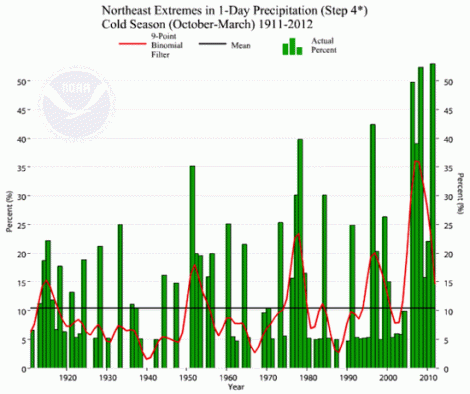The great blizzard of 2013 (which shall remain nameless) has come and gone. At least 15 people were killed, and 700,000 lost power. A nuclear power plant in Massachusetts was knocked offline. Storm surge in the state flooded several communities. In many parts of the Northeast, new one-day snowfall records were set. It was a massive storm — one whose damage could have been much worse.
Christopher Burt at the Weather Underground puts the storm in perspective:
The storm was certainly among the top five to affect Southern New England and Maine and for some localities, the worst winter storm on record (going back 300 years since European inhabitants began keeping track of such things). …
It can probably be said that winter storm Nemo was the 2nd most intense winter storm event for Long Island, Connecticut, eastern Massachusetts, and perhaps Rhode Island. For Long Island and Connecticut the Blizzard of 1888 remains unparalleled whereas for Rhode Island and eastern Massachusetts the Blizzard of 1978 remains the top event. For southeastern Maine it would appear that Nemo has been the most extreme snowstorm on record. …
I might add that it is a bit unsettling that two of the most significant storms in the past 300 years to strike the northeastern quadrant of the U.S. have occurred within just four months from one another.
Emphasis added, because it’s worth emphasizing.
In our preview of the storm last Thursday, we noted the circumstantial evidence that climate change might make the blizzard worse. Over at ThinkProgress, Joe Romm dove a lot deeper:
Like a baseball player on steroids, our climate system is breaking records at an unnatural pace. And like a baseball player on steroids, it’s the wrong question to ask whether a given home run is “caused” by steroids.
But:
The blizzard is also pulling in an extraordinary amount of moisture, which is consistent with recent trends in the Northeast toward more frequent one-day precipitation extremes during the cold season, including snowstorms. The satellite-derived image of total precipitable water shows that the storm has been drawing tropical moisture from the Pacific Ocean, Gulf of Mexico, and the Atlantic Ocean.
[Former head of the Climate Analysis Section at the National Center for Atmospheric Research Dr. Kevin] Trenberth’s second point is an important one — warmer than normal winters favor snow storms (See “We get more snow storms in warm years“).
The ThinkProgress post includes this graph, showing the growth in one-day precipitation extremes as the climate has warmed.

Did climate change create this storm? No. Did climate change make the storm bigger and more powerful? Evidence suggests it. Is it disconcerting and alarming that two major storms have struck the Northeast since the end of October? Well, I live in the Northeast. So: very much so.




